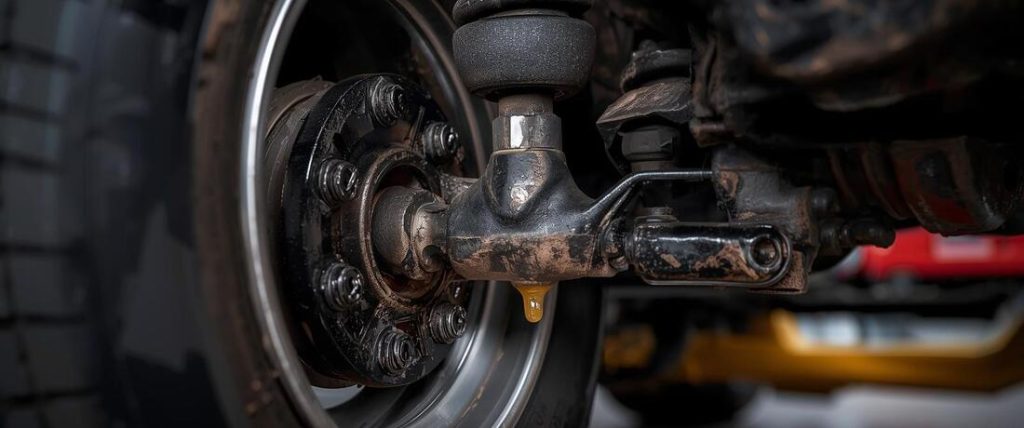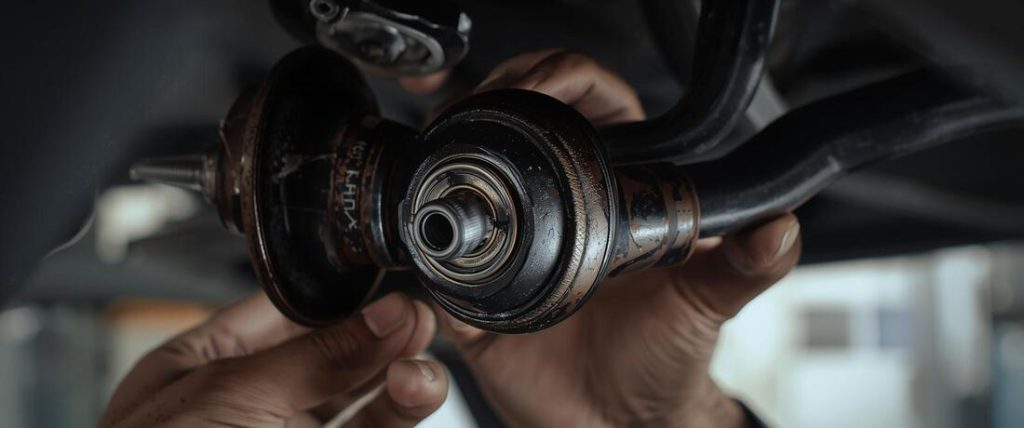This article was updated in November 19, 2025 with new products and information by Mark S. Taylor
Ever hear a weird clunk when you drive? I have, and it’s not good. That sound is often one of the first symptoms of a bad universal joint in your car.
I’ve seen many folks stuck on the road. They missed the early signs. A bad u-joint might seem small. But it can cause big problems if you wait too long.
What I love is that these signs are easy to spot. You just need to know what to look for. Strange noises and shakes are clues. Your car talks to you when the u-joint is bad.
In this guide, I’ll show you the key symptoms of a bad universal joint. I’ll teach you how to check your u-joint at home. I’ll tell you when you need to fix it. I’ll share stories that show how bad u-joint failure can be.
By the end, you’ll know how to find u-joint issues early. This can save you money and keep you safe. Let’s learn how to hear what your car is telling you.

Contents
What Is a Ball Joint and Why Do They Fail?
A ball joint is a small part with a big job. It helps your wheels move up and down. It also lets you turn left and right. Think of it like a hip joint in your body. It allows movement in many ways. Most cars have two to four ball joints. They are in the front part of your car. They hold up the weight of your car. They help you steer safely.
Role in Your Suspension and Steering System
Ball joints connect two key parts of your car. They link the control arms to the steering knuckles. This lets the wheels move up and down. It also lets them turn left and right. When they work right, your car drives smooth. It steers well. Your tires wear evenly. Bad ball joints make driving unsafe. They can cause other parts to wear out too.
Upper vs Lower Ball Joints: Key Differences
Most cars have upper and lower ball joints. They do slightly different jobs. The lower joint holds up most of the car’s weight. The upper joint helps with steering. Some new cars don’t have upper ball joints. They use struts instead. Struts do a similar job. Both types need care to work well.
Common Causes of Ball Joint Failure
Ball joints fail for a few reasons:
- Boot damage: A rubber cover can tear. Dirt gets inside the joint.
- Normal wear: The joint gets old and worn out over time.
- Rust: Water and salt can make the joint rust.
- Road hazards: Potholes and bumps can damage the joint.
- No grease: Some joints need grease to work well.
Most ball joints last 70,000 to 150,000 miles. But this can change based on how you drive. And where you live.

7 Most Common Symptoms of a Bad Ball Joint
If you notice any of these signs, check your ball joints soon. Don’t wait until it’s too late.
1. Clunking or Knocking Noises Over Bumps
The first sign of a bad ball joint is noise. You might hear a clunk when you drive over bumps. Or when you turn a corner. This sound means the joint is worn out. It has too much play. Metal parts are hitting each other. The sound comes from the front of your car. It gets worse as the joint wears more.
I once had a customer who heard a small clunk for weeks. He thought it was just his old car. Then one day, the ball joint failed on the highway. He had to pay for a tow and a big repair. Don’t make his mistake!
2. Steering Wheel Vibration or Shimmy
A bad ball joint makes your steering wheel shake. This is most clear at high speeds. The shake happens because the joint is loose. It can’t hold the wheel steady. As you drive faster, the shake gets worse.
Many people think this is a tire problem. But if new tires don’t fix it, check your ball joints. I’ve seen many people spend money on new tires when they really needed new ball joints.
3. Loose or Wandering Steering Feel
When ball joints go bad, your steering might feel loose. The car might drift or pull to one side. You have to keep fixing the steering to go straight. This happens because the worn joint lets the wheel move too much. It changes the way your car drives.
This problem is very unsafe. It makes the car hard to control. This is scary when you need to turn or stop fast.
4. Uneven or Rapid Tire Wear Patterns
Bad ball joints cause tires to wear unevenly. You might see wear on the inside or outside edge of the tire. This happens because the joint lets the wheel tilt. The tire doesn’t touch the road evenly. One tire might wear much faster than the others.
If you buy new tires often, check your ball joints. I’ve seen people buy new tires every year. The real problem was bad ball joints.
5. Squeaking or Chirping From Front End
A bad ball joint might make a squeak or chirp. You hear this when going over bumps. Or when you turn slowly. The sound happens because the joint is dry. Or dirt got inside through a torn boot. The noise might go away as the joint warms up.
Don’t ignore these small sounds. They are early warning signs. Fixing them now saves money later.
6. Vehicle Pulls to One Side
A bad ball joint can make your car pull to one side. This happens even on a straight road. The worn joint lets the wheel tilt. This changes the way the car drives. You might feel like you’re always fighting the steering.
This sign is bad for your tires. It also uses more gas. And it’s not safe to drive this way.
7. Visible Damage or Grease Leaks on Ball Joint Boot
You can see signs of bad ball joints if you look. Check for:
- Torn rubber boots around the joints
- Grease leaking from the joint area
- Rust on the joint parts
- Too much movement in the joint
These signs mean the joint needs help soon. If you see them, get your car checked.

How to Test Ball Joints at Home (Safe Step-by-Step Guide)
You can check your ball joints at home with basic tools. Here’s how I do it in my shop.
Jack Stand Method + Pry Bar Check
To check for play in the ball joints:
- Park on flat ground. Put on the parking brake.
- Loosen the nuts on the front wheels.
- Jack up the car. Put it on jack stands.
- Take off the front wheels.
- Put a pry bar under the tire.
- Lift up and down. Check for movement in the joint.
- Use another pry bar to check side-to-side movement.
If you feel a lot of play or hear a clunk, the joint is bad.
Listen/Feel Test While Driving
Pay attention to how your car drives:
- Listen for clunks over bumps.
- Feel for shaking in the steering wheel.
- Notice if the car pulls to one side.
- Pay attention to how the car steers.
These signs can help you find ball joint problems early.
Visual Boot Inspection Techniques
Look at your ball joints regularly:
- Park on flat ground. Turn the wheels all the way.
- Look at the ball joint boots for tears.
- Check for grease leaks around the joints.
- Look for rust on the joint parts.
- Use a flashlight to see all sides of the joint.
If you see these signs, get your joints checked soon.
Essential Tools Needed + Safety Tips
For safe checking, you’ll need:
- Car jack and jack stands
- Tool to remove lug nuts
- Large pry bar
- Flashlight
- Gloves and safety glasses
Always be safe when working under your car. Use good jack stands. Never trust just a jack. Make sure the car won’t move before you start.
What Happens If You Drive with Bad Ball Joints?
Ignoring a bad ball joint is a bad idea. It can lead to big problems.
Risk of Wheel Separation and Loss of Control
A very worn ball joint can break while you’re driving. This makes the wheel fall off the car. You can lose control of the car. This is very dangerous. The wheel might fold under the car. This can cause a bad crash.
I once saw a car lose a wheel on the highway. The ball joint broke without warning. The driver almost hit many other cars. Don’t let this happen to you.
Damage to Tires, Control Arms, and Alignment
A bad ball joint can harm other parts of your car:
- Tires wear out fast and uneven
- Control arms can get damaged
- The car’s alignment gets bad
- Other steering parts can wear out
The shaking from a bad joint can loosen bolts. This creates more problems that cost a lot to fix.
Real Repair Costs If Ignored ($1,000–$4,000+)
If you wait too long, repair costs go up a lot:
- Ball joint replacement: $200-$500 per wheel
- Wheel alignment: $75-$150
- New tires (if they wore uneven): $400-$1,200
- Control arm replacement (if damaged): $300-$800 per side
- Other steering fixes: $200-$1,000+
Fixing ball joints early saves you thousands of dollars.
Ball Joint Replacement Costs and Best Options in 2026
When you need to replace a ball joint, you have choices. Here’s what you need to know.
Average $300–$800 Per Corner (Parts + Labor)
Ball joint costs vary by car type:
| Car Type | Parts Cost | Labor Cost | Total Cost |
|---|---|---|---|
| Small Car | $50-$150 | $200-$400 | $250-$550 |
| Truck/SUV | $80-$250 | $250-$500 | $330-$750 |
| Sports Car | $150-$350 | $300-$600 | $450-$950 |
These costs can change based on where you live. The exact car matters too. So does the shop you choose.
Greasable vs Sealed Ball Joints (Comparison Table)
When you need new ball joints, think about:
| Feature | Greasable Joints | Sealed Joints |
|---|---|---|
| Care | Need grease added | No care needed |
| Life | Last longer with care | Limited by factory grease |
| Cost | Usually cost less | Often cost a bit more |
| Install | May need grease fitting | Simpler to install |
| Strength | Good in tough conditions | Might fail sooner in harsh use |
Top Recommended Brands (MOOG, Mevotech, Spicer)
When you need new ball joints, think about these brands:
- MOOG: Makes many types of ball joints. They last long. They have good warranties.
- Mevotech: Has standard and premium options. They have strong ball studs. They have better boot designs.
- Spicer: Makes strong ball joints for trucks. They are tough for hard work.
Ask your mechanic what’s best for your car. Tell them how you drive. This helps them pick the right part.
DIY vs Professional Shop Replacement
Doing it yourself:
- Parts cost: $50-$250 for each wheel
- Tools needed: Basic tools, maybe a press
- Time: 2-4 hours if you know what you’re doing
- Think about: You need to know what you’re doing. You need to be safe.
Shop replacement:
- Cost: $250-$750 for each wheel
- Time: Usually done in one day
- Think about: Comes with a warranty. A pro does the work.
I tell my customers: if you’re not sure, let a pro do it. It’s worth the cost to stay safe.
How to Prevent Premature Ball Joint Failure
With good care, your ball joints can last a long time. Here’s how I keep mine in good shape.
Regular Inspection Schedule
Follow these tips to keep your joints working:
- Look at them often: Check the boots when you get oil changes.
- Listen for sounds: New noises mean you should check soon.
- Feel how the car drives: Changes in steering can mean problems.
- Get a pro check: Have a mechanic look at your car once a year.
These simple steps help find problems early. This saves you money later.
Avoiding Potholes and Heavy Loads
To help your ball joints last longer:
- Drive slow on bad roads. Avoid potholes.
- Slow down for speed bumps and train tracks.
- Don’t carry too much weight in your car.
- Don’t hit curbs when you park.
- Take turns at a good speed.
These habits help your joints last longer. They save you money and keep you safe.
Proper Greasing Techniques for Greasable Joints
If your car has greasable joints, follow these tips:
- Use the right grease: Use good quality grease made for ball joints.
- Grease them often: Add new grease every 15,000 miles or with oil changes.
- Don’t add too much: Add grease slow. Stop when the boot expands a little.
- Clean first: Wipe the grease fitting clean before adding new grease.
Good greasing can make your joints last much longer. It stops them from failing too soon.
FAQs for “Symptoms of a Bad Ball Joint”
How do you know if you have a bad ball joint?
You can spot a bad ball joint by listening for clunks when you hit bumps. Your steering wheel might shake. Your tires may wear out fast or uneven. Your car could pull to one side. The steering might feel loose. If you see these signs, get your joints checked soon.
How do I know if I need ball joints or tie rods?
Bad ball joints make clunks over bumps. They cause uneven tire wear. Bad tie rods make steering feel loose. They cause feathered tire wear. To test, jack up your car. Move wheels side to side. Play means tie rods. Up-down play means ball joints.
Is replacing ball joints a big job?
Yes, replacing ball joints is a big job. It needs special tools. The joint must be pressed out of the control arm. After replacement, you need a wheel alignment. The job takes about 2-4 hours for a pro. Many people choose to have a shop do this work.
How long can you drive on a bad ball joint?
You should not drive long on a bad ball joint. It’s very unsafe. A bad joint can break without warning. This could make your wheel fall off while driving. If you think your joint is bad, get it fixed right away. Don’t wait until it breaks completely.
Upper vs lower ball joint symptoms: what’s the difference?
Lower ball joints hold up most of your car’s weight. When they fail, you hear loud clunks. Your steering wheel might shake a lot. Upper ball joints help with steering. When they fail, your car might pull to one side. The steering can feel loose or vague.
Bottom Line – Get Your Ball Joints Checked Today
Recap of Top 3 Red Flags to Watch For
- Clunking sounds: Listen for knocks when you go over bumps.
- Steering problems: Pay attention to shaking or pulling to one side.
- Uneven tire wear: Check for strange wear patterns on your tires.
Safety First: Early Detection Saves Money and Prevents Accidents
If you notice any of these signs, get your joints checked now. Finding problems early saves money. More importantly, it keeps you safe on the road. Don’t wait until a joint breaks. Schedule a check-up as soon as you notice any warning signs.
Quick Summary
- Ball joints connect your wheels to your suspension. They let you steer and go over bumps.
- Common signs of bad joints include clunks, shaking, and uneven tire wear.
- You can check joints at home with basic tools and safety precautions.
- Ball joint replacement costs $250-$750 per wheel, depending on your car.
- Regular checks and careful driving help joints last longer.
- Ignoring joint problems can lead to wheel separation and dangerous driving.
- Fixing problems early saves money and keeps you safe on the road.
